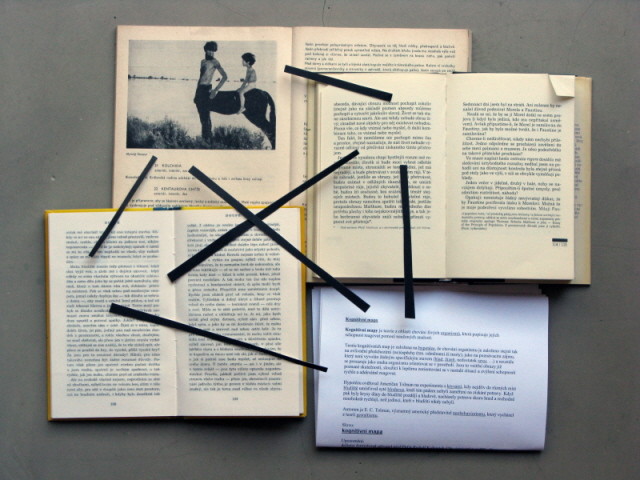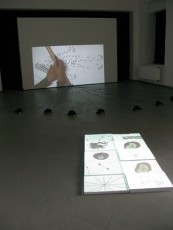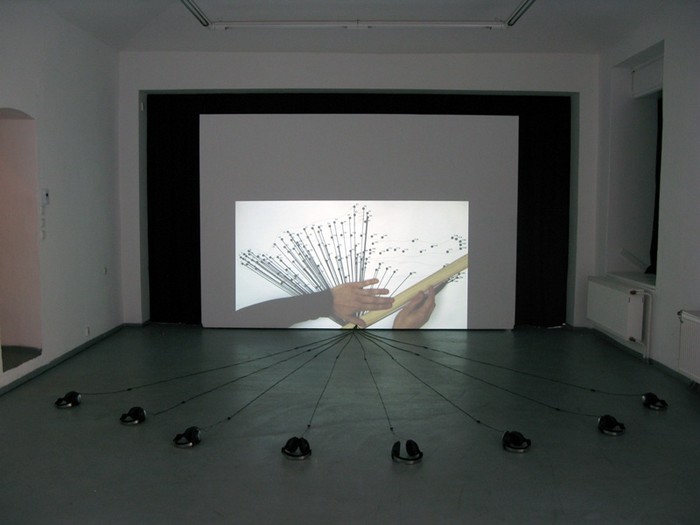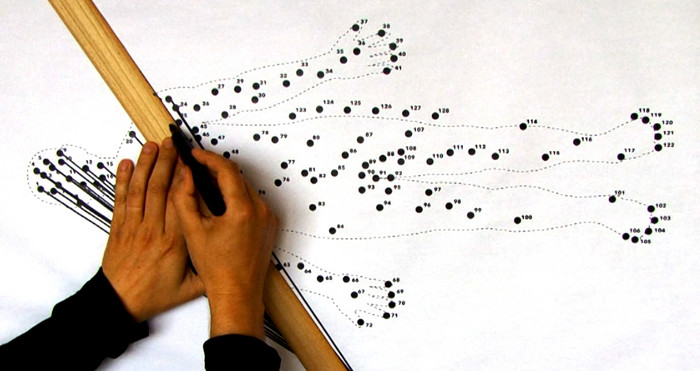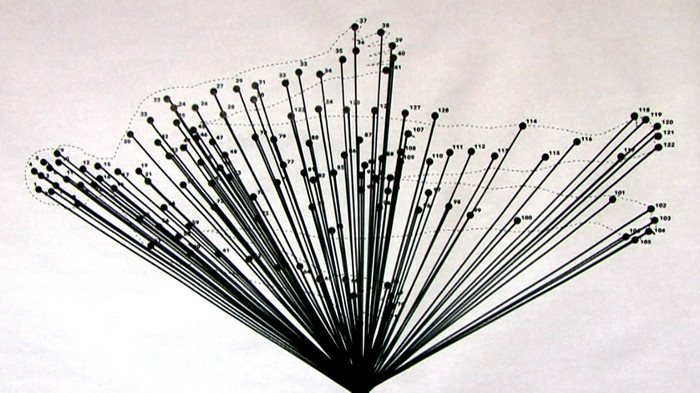ZBYNEK BALADRAN: Cognitive Maps
23 Sep - 21 Nov 2009
Zbynek Baladrán
Cognitive Maps
23/9 – 21/11/09
hunt kastner is very pleased to present our first solo show by the Prague based artist Zbynek Baladrán, which includes two new video installations made specifically for exhibition entitled Cognitive Maps.
Cognitive maps – mental maps, guides or models - are a method that we use to construct and store spatial knowledge in our memories, allowing the “mind’s eye” to visualize, code and store information, and then recall, decode and make use of it at a later date, when needed. In 2004, the Czech art historian, David Kulhánek, prefaced his article “The Praxis, Theory and Exposition of Zbynek Baladrán”, in Umelec magazine, with a quotation by Gilles Delueze: “In art, as in society and the individual, one can find specific maps. Some lines present something, others are abstract. Some are with segments, others without... We think that the lines are constitutional parts of the things and events. Therefore everything has its geography, its cartography, its diagram.” Zbynek Baladrán has often been described as an archaeologist of knowledge and memory, and he continues to use maps and diagrams in his work as a representational means to visualize concepts, ideas and relations in a structured and clear way.
In the video installation Assemblages Against Essences (HD video projection on 10 stacks of white paper), ten constantly changing images are projected onto a surface of ten stacks of blank white paper that represent a dynamic map, as well as a projected model. As the individual images change, new patterns are formed, and then disappear, creating a sort of cosmological model through the ever newly appearing constellations of pictures and drawings. Never static, the overall picture is constantly changing. At times, it seems that the different images are completely random and independent of each other; at other times, they seem to create a pattern when viewed in sequence; and at other times, they all suddenly merge together and form one single, larger picture. The overall result is a mesmerizing assemblage of different images and maps of various dimensions that continually change their character and testimony over time. The identity of the assemblage, throughout all its varying levels and dimensions, is based on the singularity of this process.
In Boundaries of Autonomy (HD video projection and 8 headphones), a wall projection shows a diagram of the human body that is made up of 128 points. One by one, the artist then proceeds to connect each of these individual points, using a pencil and ruler, to one central point, located at the bottom of the projection where the wall meets the floor. Leading out from this central point, onto the gallery floor, are eight long black wires with headphones attached to the ends. On each headphone can be heard a reading from the book “The Nerves of Government: Models of Political Communication and Control“ by Karl W. Deutsch (a prominent Czech-born social and political scientist, known for his quantitative methods and interest in formal system analysis and model thinking). This audio-visual installation is an exercise in defining representational models that describe the subjective perception of individuals, as well as our society as a whole. The diagram only becomes fully in momentum once the viewer, by putting on the headphones, finds themselves physically connected to the drawing in the projection. The repeating gestures of connecting each individual body point to the lower central boundary point, which marks the border between the visual and the audio, fills the viewers’ minds.
Zbynek Baladrán (born 1973 in Prague), studied art history at the Charles University Philosophical Faculty in Prague from 1992-2007, and from 1997-2003 at the Prague Academy of Fine Arts in the studio of visual communication under Jirí David, painting studio under Vladimír Skrepl, and new media studio under Veronika Bromová. He is one of the co-founders and a curator of Galerie Display, which was established in Prague in 2001, and in 2007 merged with Tranzit.cz into Tranzitdisplay, where he continues to oversee the exhibition program. He is also the co-curator, with Vít Havranek (director of tranzit.cz), of the project and exhibition Monument to Transformation, a 2-year research project on social transformation that was presented this year at the Prague City Gallery, and which will travel to several other locations in Europe and the U.S. later this year. Baladrán is also a part of the team of curators (Alexandria Contemporary Arts Forum, Chamber of Public Secrets, and Tranzit.org) for Manifesta 8, which will be held in Murcia, Spain in 2010.
Baladrán has exhibited extensively, both in the Czech Republic - Biennale of the Young (2005, 2008); Prague Biennale (2007, 2009), Chalupecký Award Finalists (2004, 2005, 2007, 2008), as well as internationally - Manifesta 5 (2004), Kunsthaus Basel (2005), Apex Art in New York (2006), Frankfurter Kunstverein (2006), Index Foundation Stockholm (2007), Wiener Secession Display Case in Vienna (2008). His most recent solo exhibitions (in 2008) include Time Crunch at castillo/corrales in Paris, What History Do They Represent? (with Vangelis Vahos) at Blow de la Barra in London, and Instruments of Uncertainty at the mestske kulturní domy in Ceské Budejovice. His work can also currently be seen at the 3rd Moscow Biennale at the Solyanka Gallery, until Oct. 25th, and at the Prague City Gallery, in Karel Tiege/Zbynek Baladrán: An Asymmetic Harmony, until Nov. 1, 2009.
Cognitive Maps
23/9 – 21/11/09
hunt kastner is very pleased to present our first solo show by the Prague based artist Zbynek Baladrán, which includes two new video installations made specifically for exhibition entitled Cognitive Maps.
Cognitive maps – mental maps, guides or models - are a method that we use to construct and store spatial knowledge in our memories, allowing the “mind’s eye” to visualize, code and store information, and then recall, decode and make use of it at a later date, when needed. In 2004, the Czech art historian, David Kulhánek, prefaced his article “The Praxis, Theory and Exposition of Zbynek Baladrán”, in Umelec magazine, with a quotation by Gilles Delueze: “In art, as in society and the individual, one can find specific maps. Some lines present something, others are abstract. Some are with segments, others without... We think that the lines are constitutional parts of the things and events. Therefore everything has its geography, its cartography, its diagram.” Zbynek Baladrán has often been described as an archaeologist of knowledge and memory, and he continues to use maps and diagrams in his work as a representational means to visualize concepts, ideas and relations in a structured and clear way.
In the video installation Assemblages Against Essences (HD video projection on 10 stacks of white paper), ten constantly changing images are projected onto a surface of ten stacks of blank white paper that represent a dynamic map, as well as a projected model. As the individual images change, new patterns are formed, and then disappear, creating a sort of cosmological model through the ever newly appearing constellations of pictures and drawings. Never static, the overall picture is constantly changing. At times, it seems that the different images are completely random and independent of each other; at other times, they seem to create a pattern when viewed in sequence; and at other times, they all suddenly merge together and form one single, larger picture. The overall result is a mesmerizing assemblage of different images and maps of various dimensions that continually change their character and testimony over time. The identity of the assemblage, throughout all its varying levels and dimensions, is based on the singularity of this process.
In Boundaries of Autonomy (HD video projection and 8 headphones), a wall projection shows a diagram of the human body that is made up of 128 points. One by one, the artist then proceeds to connect each of these individual points, using a pencil and ruler, to one central point, located at the bottom of the projection where the wall meets the floor. Leading out from this central point, onto the gallery floor, are eight long black wires with headphones attached to the ends. On each headphone can be heard a reading from the book “The Nerves of Government: Models of Political Communication and Control“ by Karl W. Deutsch (a prominent Czech-born social and political scientist, known for his quantitative methods and interest in formal system analysis and model thinking). This audio-visual installation is an exercise in defining representational models that describe the subjective perception of individuals, as well as our society as a whole. The diagram only becomes fully in momentum once the viewer, by putting on the headphones, finds themselves physically connected to the drawing in the projection. The repeating gestures of connecting each individual body point to the lower central boundary point, which marks the border between the visual and the audio, fills the viewers’ minds.
Zbynek Baladrán (born 1973 in Prague), studied art history at the Charles University Philosophical Faculty in Prague from 1992-2007, and from 1997-2003 at the Prague Academy of Fine Arts in the studio of visual communication under Jirí David, painting studio under Vladimír Skrepl, and new media studio under Veronika Bromová. He is one of the co-founders and a curator of Galerie Display, which was established in Prague in 2001, and in 2007 merged with Tranzit.cz into Tranzitdisplay, where he continues to oversee the exhibition program. He is also the co-curator, with Vít Havranek (director of tranzit.cz), of the project and exhibition Monument to Transformation, a 2-year research project on social transformation that was presented this year at the Prague City Gallery, and which will travel to several other locations in Europe and the U.S. later this year. Baladrán is also a part of the team of curators (Alexandria Contemporary Arts Forum, Chamber of Public Secrets, and Tranzit.org) for Manifesta 8, which will be held in Murcia, Spain in 2010.
Baladrán has exhibited extensively, both in the Czech Republic - Biennale of the Young (2005, 2008); Prague Biennale (2007, 2009), Chalupecký Award Finalists (2004, 2005, 2007, 2008), as well as internationally - Manifesta 5 (2004), Kunsthaus Basel (2005), Apex Art in New York (2006), Frankfurter Kunstverein (2006), Index Foundation Stockholm (2007), Wiener Secession Display Case in Vienna (2008). His most recent solo exhibitions (in 2008) include Time Crunch at castillo/corrales in Paris, What History Do They Represent? (with Vangelis Vahos) at Blow de la Barra in London, and Instruments of Uncertainty at the mestske kulturní domy in Ceské Budejovice. His work can also currently be seen at the 3rd Moscow Biennale at the Solyanka Gallery, until Oct. 25th, and at the Prague City Gallery, in Karel Tiege/Zbynek Baladrán: An Asymmetic Harmony, until Nov. 1, 2009.

